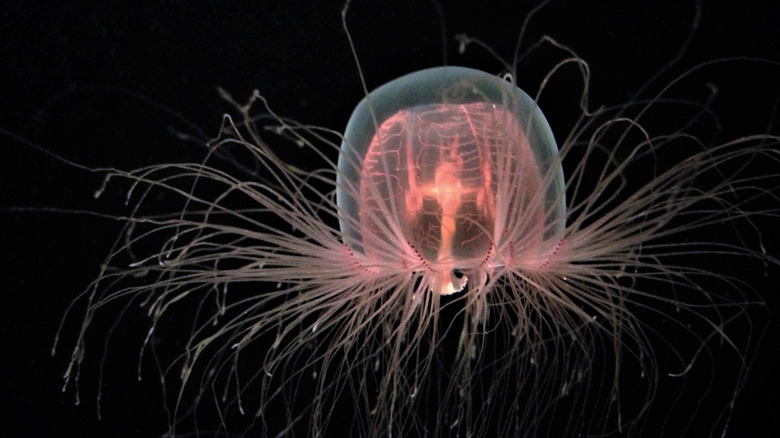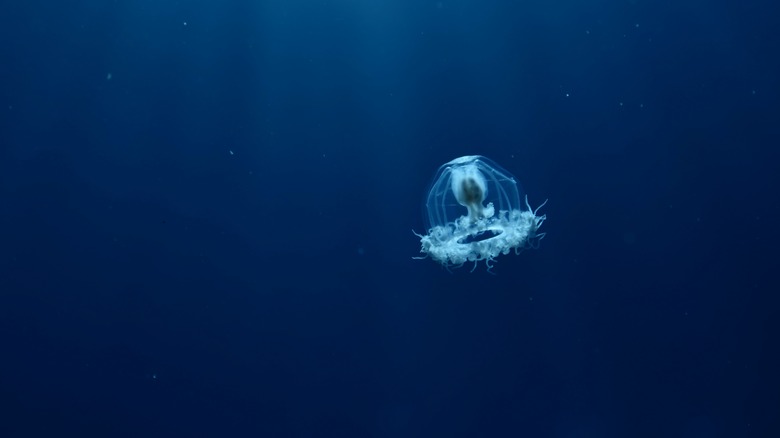How One Jellyfish Is Capable Of Near-Immortality
Jellyfish are curious creatures. They have an ethereal, otherworldly, Lovecraftian look about them, which makes them instantly fascinating. Some of the most ancient and varied critters on the planet, they date back at least 500 million years (per World Atlas), and we've only identified around 2,000 types of jellyfish (there may be more than 300,000 others still unknown to science).
Some are tiny, and others are impossibly gigantic. World Atlas goes on to say that some jellyfish have 200 feet of tentacles. These unknowable, mysterious creatures can pose a significant danger, too. In the paper "A Randomized, Controlled Field Trial for the Prevention of Jellyfish Stings With a Topical Sting Inhibitor" (via the National Library of Medicine), David Boulware states, "jellyfish stings are a common occurrence among ocean goers worldwide with an estimated 150 million envenomations annually."
That's an awful lot of stings, but with these magnificent floating beings, the wonders never cease. One particular type of jellyfish is, for all intents and purposes, immortal.
How a jellyfish can possibly be 'immortal'
Of course, there are lots of animals on Earth that simply live a very long time. Giant tortoises, for one, can far outstrip humans in longevity. According to Guinness World Records, the oldest living land animal is a Seychelles giant tortoise named Jonathan, who was believed to be 190 years old (and probably even older) in 2022. The so-called immortal jellyfish, however, uses some brilliant trickery to achieve immortality (or something incredibly close to it).
The Natural History Museum states that this marvelous creature has the scientific name of Turritopsis dohrnii. Turrit, as it might well be known by its friends, is a species of hydrozoan that does technically age and mature like so many other living beings do. Remarkably, however, it is actually able to rewind the process.
Per the Natural History Museum's Miranda Lowe, jellyfish, after fertilization, become "a free-swimming larval form. The larva will move about in the current until it finds a hard surface to establish itself. It will then start to mature and grow. Larvae mature into polyps, which will then bud off and mature into young jellyfish."
Perhaps the closest to immortality a living creature can get
This is reportedly typical of jellyfish reproduction, but the thing that sets Turritopsis dohrnii apart (per the Natural History Museum) is that it can respond to injury or other life-threatening circumstances by retracting its mature tentacles and becoming an immobile, earlier form of itself again. It will then become a polyp in the space of a day or two, and medusae (mature jellyfish) are the result.
Transdifferentiation, Britannica explains, is the process by which one type of differentiated cell becomes another. Newts, per Britannica, can recreate the lost lens of an eye because some of the cells of the iris essentially 'become' lens cells. This is what the immortal jellyfish is doing, per Natural History Museum: The complex life cycle of the creature develops backwards, with polyp cells becoming medusae cells initially and then vice versa when the jellyfish is about to die. All of this in a remarkable species that is just 4.5 milimeters (0.45 centimeters) in size.
It's a difficult concept to fathom, but put simply, this ability is similar to that of the mythological phoenix. This fiery bird, according to legend, could start its life anew from its own ashes. The fact that a real living creature can do largely the same thing is truly incredible.


